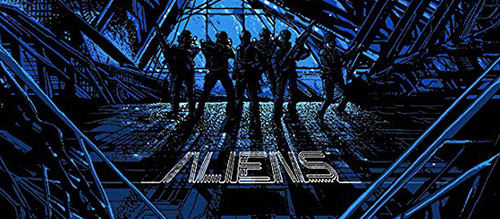

Cold, sinewy passages drip with bodily fluids and shape corridors like rib cages and oesophagi via mysterious, unseen methods. Once the team reach the infected colony, however, there’s far more emphasis on the biological colonising of the xenomorphs. The obsession with spaces remains, and Scott’s slow, exploratory camerawork through spaceship interiors remains, though the USS Sulaco is obviously populated with mechanical weaponry and tools as opposed to the biological parallels of the Nostromo. The Weyland/Yutani logo is plastered on every wall and uniform, and Bourke offers an equally chilling counterpoint to the influx of artificial persons, proof that you don’t need to be made of tubing and programming to become robotically unfeeling. Now faceless corporations take the place of Ash’s role from the first film. Ripley’s aversion to synthetic lifeforms is tested by Bishop who, after spouting Asimov’s laws of robotics to assure her safety, eventually becomes an invaluable saviour. But the thematic, horrific groundwork established by Scott shouldn’t be forgotten, nor is it. Once the set pieces really get going, it’s easy to appoint Aliens as the standard for action filmmaking, that is until Cameron one-upped himself again with Terminator 2. Unlike the Nostromo crew, the marines “deserve” to die in the cinematic sense, making the final act all the more satisfying when the more resolved, emotionally capable Ripley is once again forced to take her stand against the extraterrestrial threat. There’s a reason why “game over, man!” has resonated so heavily toxicity and machismo are easy shields to hide behind, but the layers quickly wear thin when tragedy levels the playing field.Ĭameron is clearly playing into 80s slasher tropes here in comparison to Scott’s more measured approach to the series’ characters.


Aliens forged the concept of space marines that inspired so many film and video game properties to come, but it must be remembered that their initial creation was masked by insecurity. The great Bill Paxton strutting around his team of “ultimate bad-asses”, Apone chewing his cigar to shreds, the sick burns and sexual boasts at breakfast. Not only does the literal bad-assery of the revolutionary action scenes still hold up remarkably, but the swaggering insistence of the colonial marines to occupy ultra-masculine, hostile personas offer a transparent misdirect for the imminent carnage. Since watching it for the first time, I’ve always made sure to use the Director’s Cut upon revisits, as the development of Ripley from a bereaved mother to the guardian of recently orphaned Newt, which is all but missing in the theatrical version, felt like a crucial counterpoint to the colonial marines’ misplaced bravado.Įverything is “bad-ass” in Aliens. Perhaps the rankings would change in light of Mad Max: Fury Road, Blade Runner 2049 and a handful of others, but its level of prestige has always stood my opinion in good stead. Ten years ago, Empire Magazine named the film the best sequel ever made. After teasing myself with that gripping opening sixty minutes or so, finally getting the film to myself and witnessing that explosive final hurdle undoubtedly blew my adolescent mind. Maybe it’s simply because, as a kid, it took me about three distinct occasions to sit down and get through the damn thing, thanks to a combination of its weighty runtime and a hyperactive group of friends. I’ve always felt that Aliens just about had the edge over Ridley Scott’s original. Starring: Sigourney Weaver, Michael Biehn, Bill Paxton, Carrie Henn This article was written exclusively for The Film Magazine by Lucas Hill-Paul.


 0 kommentar(er)
0 kommentar(er)
